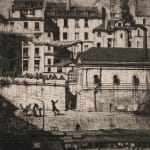Charles Meryon (1821-1868)
The Mortuary, Paris (La Morgue), 1854
Etching on thin laid paper
213 x 191 mm. (8 3/8 x 7 1/2 inches)
Initialed 'CD'
Watermark
Watermark
Delteil/Wright 36 third state (of seven), Schneiderman 42 third state (of seven)
A superb atmospheric impression, with extensive and selective wiping of the plate, and particularly effective inking and plate tone in the ominous clouds of smoke and the shadowy areas at...
A superb atmospheric impression, with extensive and selective wiping of the plate, and particularly effective inking and plate tone in the ominous clouds of smoke and the shadowy areas at the left. The richness of the lines attest to the fine condition of the plate at this stage of its evolution. This is of course a proof impression hand printed by Meryon.
Impressions of the Morgue in the third state are of the utmost rarity. One impression of the first state is known (National Gallery), two of the second (Cincinnati and Paris), and eight of the third. Other impressions of this state have not come on the market, making this possibly the only impression of the third state still available (cf. James D. Burke, Charles Meryon Prints and Drawings, p. 70; other third state impressions are in Cincinnati, Chicago, Detroit, London, New York, New York PL, and Washington).
In this state the borderline and work on the composition are complete, but the inscriptions in cursive at the lower border have yet to be entered (including the name, date, address). The Morgue is one of the Meryon’s greatest achievements, and a landmark in nineteenth century printmaking. It was done as part of Meryon’s program of creating etchings of some of the wonderful architectural landmarks of Paris that had remained essentially untouched through the years, but that were likely to be demolished or moved. (The morgue, moved after the etching was made, stood on the Île de la Cité, built in 1568, and formerly an abattoir.) The superimposed roofs, the collision of angles, the striking contrasts of shadows all create an aesthetic excitement that was new to the art of its time, and eventually became recognized as an early expression of modernism, presaging cubism, and even precisionism. The composition has a mysterious quality –not only because of its subject matter– but because of the extraordinary mood Meryon achieves through the interplay of lights and shapes.
Impressions of the Morgue in the third state are of the utmost rarity. One impression of the first state is known (National Gallery), two of the second (Cincinnati and Paris), and eight of the third. Other impressions of this state have not come on the market, making this possibly the only impression of the third state still available (cf. James D. Burke, Charles Meryon Prints and Drawings, p. 70; other third state impressions are in Cincinnati, Chicago, Detroit, London, New York, New York PL, and Washington).
In this state the borderline and work on the composition are complete, but the inscriptions in cursive at the lower border have yet to be entered (including the name, date, address). The Morgue is one of the Meryon’s greatest achievements, and a landmark in nineteenth century printmaking. It was done as part of Meryon’s program of creating etchings of some of the wonderful architectural landmarks of Paris that had remained essentially untouched through the years, but that were likely to be demolished or moved. (The morgue, moved after the etching was made, stood on the Île de la Cité, built in 1568, and formerly an abattoir.) The superimposed roofs, the collision of angles, the striking contrasts of shadows all create an aesthetic excitement that was new to the art of its time, and eventually became recognized as an early expression of modernism, presaging cubism, and even precisionism. The composition has a mysterious quality –not only because of its subject matter– but because of the extraordinary mood Meryon achieves through the interplay of lights and shapes.



